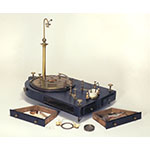Large galvanometer designed by Leopoldo Nobili c. 1825. The instrument is mounted on a wooden base carrying a slender suspension pillar. A pair of astatic needles is suspended from the fine silk wire attached to a torsion mechanism at the top of the pillar. The needles can be raised or lowered by means of a complex screw-operated scissors-type mechanism. The lower needle passes through a slit into a flat coil of insulated silk wire, wound on a wooden bobbin; the upper needle indicates the deflections on a semicircular graduated brass scale, divided into two quadrants. The magnetic compass on the base of the instrument can be replaced by a small porcelain dish for measuring the current produced by different metals; or, using another attachment consisting of a wire held above a compass needle, the compass can be used to give a rough measure of the current produced by electrochemical batteries. The black wooden base contains two drawers with accessories. In this and other galvanometers, Nobili cleverly combined elements—such as the suspension, the "multiplying" coil, and astatic needles—already used in other instruments, to produce a highly efficient device for measuring currents.
The instrument, heavily restored after the 1966 Arno flood, is now incomplete. The glass bell-jar is lost. Provenance: Lorraine collections.










